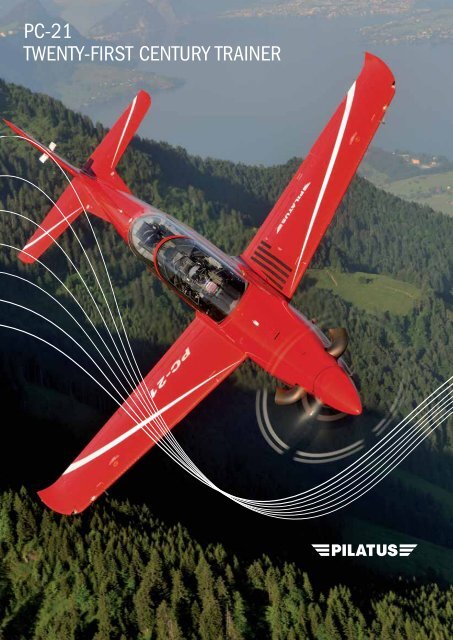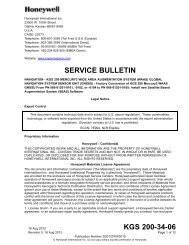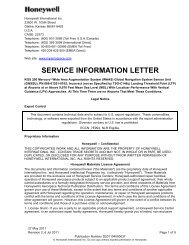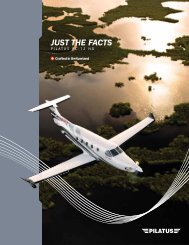PC-21 TWENTY-FIRST CENTURY TRAINER - Pilatus Aircraft
PC-21 TWENTY-FIRST CENTURY TRAINER - Pilatus Aircraft
PC-21 TWENTY-FIRST CENTURY TRAINER - Pilatus Aircraft
Create successful ePaper yourself
Turn your PDF publications into a flip-book with our unique Google optimized e-Paper software.
<strong>PC</strong>-<strong>21</strong><br />
<strong>TWENTY</strong>-<strong>FIRST</strong> <strong>CENTURY</strong> <strong>TRAINER</strong>
<strong>PC</strong>-<strong>21</strong><br />
<strong>TWENTY</strong>-<strong>FIRST</strong> <strong>CENTURY</strong> <strong>TRAINER</strong><br />
<strong>Pilatus</strong> <strong>Aircraft</strong> Ltd’s newest turboprop product, the <strong>PC</strong>-<strong>21</strong>, has been<br />
developed and certified as a completely new training system with the<br />
objective of meeting the expectations of modern air forces over the<br />
next 30 years, both in terms of capability and life-cycle cost.<br />
The <strong>PC</strong>-<strong>21</strong> has a superior aerodynamic performance when compared<br />
with any other turboprop trainer on the market, a more powerful, flexible<br />
and cost-effective integrated training system than any other jet or<br />
turboprop trainer and a life-cycle support cost equal to current turboprop<br />
benchmarks.<br />
Basic Flying Training<br />
Advanced Flying Training<br />
Full Mission Management Training<br />
Embedded Simulation and Emulation<br />
Pressurized, stepped, tandem<br />
cockpit with birdstrike<br />
resistant canopy<br />
On-Board Oxygen<br />
Generating System<br />
(OBOGS)<br />
Anti-g system<br />
Scimitar five-blade<br />
graphite propeller<br />
0-0 ejection<br />
seats<br />
1600 shp Pratt &<br />
Whitney PT6A-68B<br />
engine with power<br />
management software<br />
2.388 m (7 ft 10 in.) dia.<br />
2.736 m (8 ft 11 in.)<br />
Automatic yaw<br />
compensation<br />
Pressurized refuelling<br />
Open architecture mission<br />
computer with AMLCD<br />
monitors and separate critical<br />
and non-critical software<br />
8 g, high speed profile<br />
wing with hydraulic<br />
ailerons and spoilers<br />
9.108 m (29 ft 11 in.)<br />
The <strong>PC</strong>-<strong>21</strong>, in the aerobatic configuration, has the following performance<br />
under international standard atmospheric (ISA) conditions:<br />
Take-off distance over 50 ft<br />
(15 m) obstacle at sea level 2,379 ft (725 m)<br />
Landing distance over 50 ft<br />
(15 m) obstacle at sea level 2,953 ft (900 m)<br />
Max. rate of climb, sea level 4,250 ft/min (<strong>21</strong>.59 m/sec)<br />
Max. operating speed (V mo ) 370 KEAS (685 km/h)<br />
Max. horizontal speed (V H ) at sea level 323 KTAS (598 km/h)<br />
Max. horizontal speed (V H ) at 10,000 ft 337 KTAS (624 km/h)<br />
Stall speed<br />
- flaps and gear up (V s ) 92 KEAS (170 km/h)<br />
- flaps and gear down (V so ) 81 KEAS (150 km/h)<br />
g loads Aerobatic Utility<br />
- Max. positive + 8.0 g + 5.0 g<br />
-Max.negative –4.0g –2.5g<br />
Max. range 720 NM (1,333 km)<br />
Basic empty weight<br />
(depending on configuration) 5,026 lb (2,280 kg)<br />
Max. take-off weight, aerobatic 6,834 lb (3,100 kg)<br />
Max. take-off weight, utility 9,370 lb (4,250 kg)<br />
2.497 m<br />
(8 ft 2 in.)<br />
2.014 m<br />
(6 ft 7 in.)<br />
11.233 m (36 ft 11 in.)<br />
Wing area<br />
15.2<strong>21</strong> m 2 (163.848 ft 2 )<br />
1.000 m<br />
(3 ft 3 in.)<br />
3.749 m<br />
(12 ft 4 in.) typical<br />
4.000 m (13 ft 1 in.)<br />
www.pilatus-aircraft.com








